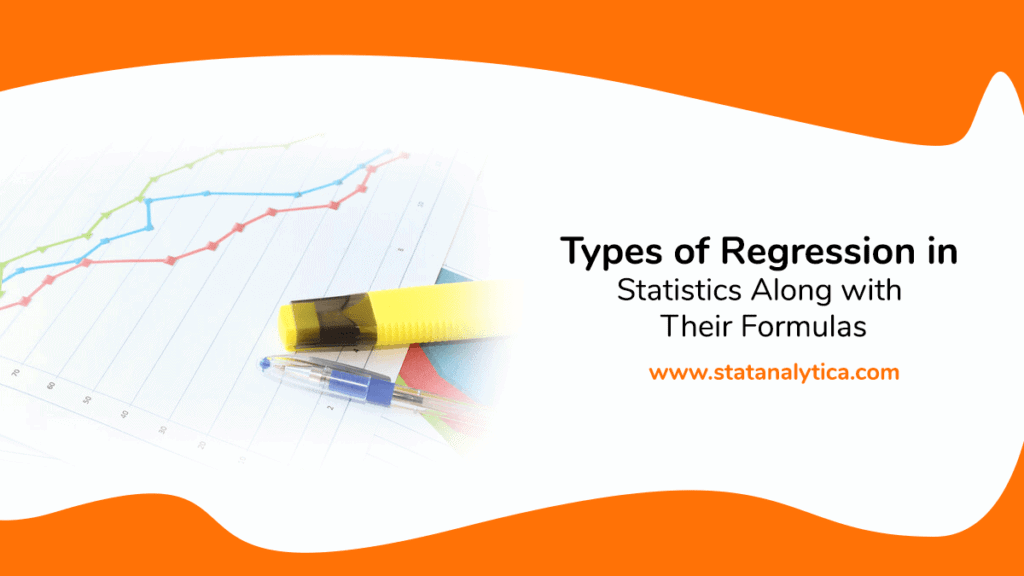There are different types of regression in statistics, but before proceeding to the details of them. Let’s get some information on what is a statistical regression? Regression is the branch of the statistical subject that plays an important role in predicting the analytical data. It is also used to calculate the connection between the dependent variables with single or more predictor variables. The main objective of the regression is to fit the given data in a way that they must exist in minimum outliers.
Regression is the supervised machine learning method and an integral section of predictive models. In other words, regression means a curve or a line that passes through the required data points of X-Y plot in a specific way that the distance between the vertical line and all the data points is considered to be minimum. The distance between the points and the lines specifies whether the sample has a strong connection, and then it is called a correction.
Regression analysis basically used for the following analysis:
- Predict the impact of change.
- Causal analysis.
- Predict trends.
The applications of regression make it beneficial for sales, market research, and stock forecasting, and others. On the basis of several types of regression methods that represent the number of independent variables and the connection between these variables. The different types of regression are:
Types of Regression
Table of Contents
Linear regression
It is the basic regression sample that is used to analyze the basics of regression. If we have a single variable (X) and other variables (Y) then this types of regression can be used to show the linear relationship between each other. This is known as linear regression. If there is more than single predictors then this can be called a multiple linear regression sample. The linear regression can be defined as:
y=ax+b+e
Where a = slope of the line, b = y-intercept, e = error term.
The line can be used to determine the values of parameters a and b and the coefficient of x and intercept can be predicted by the least square that minimizes the addition of square errors within the given sample data. The difference between the calculated value Y and forecasted value y is called a prediction error, that is represented as:
Q = Σ(Y-y)^2
Polynomial Regression
It is somehow similar to the multiple linear regression. In these types of regression, the relationship between variable X and Y is represented as a Kth degree of the polynomial X. It fits for the data of non-linear samples, also fits for linear samples for an estimator. It can be fitted by utilising the least square technique but it needs to be interpreted the values in single monomials that has to be highly correlated. The assumed value of the dependent variable Y can be modelled by the equation:
Y = a_1*X_1 + (a_2)²*X_2 + (a_3)⁴*X_3 ……. a_n*X_n + b
The line which passes through the points might not be straight but it can be curved as it depends on the power of X. The highest degree of the polynomials can be easily calculated by introducing the more oscillations within the observed curves and it might have low interpolator properties. Use modern approaches, the polynomial regression can be used as a Kernel for Support Vector Machines algorithms.
Ridge regression
We can say that it is another types of regression that is a robust version of the linear regression that is less suitable for overfitted values. The sample provides a few penalization or constraints of the addition of squares of the coefficients of regression. The technique of least square can estimate the parametric values of the least variance. The bias factor can be involved in alleviating the issues if the predictor variables are highly corrected. To eliminate the problem, Ridge Regression sum a small squared bias factor to the variables:
min || Xw — y ||² + z|| w ||²
OR
min || Xw – y ||²
Where X defines the feature variables, w defines the weights, and y defines the ground truth.
A bias matrix method used to sum the least square equations and finally the addition of squares can minimize and perform the value of low variance parameters. The bias matrix is also important for scalar multiple identical matrices where the optimum value requires to get selected.
LASSO Regression
LASSO stands for Least Absolute Shrinkage Selector Operator. It is the types of regression that is an alternative to the ridge regression. The only difference is this is used to penalizes the size of the coefficient of regression. Using the penalize method, the coefficient of estimated shrink towards the zero value that is not possible with the method of ridge regression.
However, rather than using a squared bias such as ridge regression, lasso rather utilize an absolute value bias:
min || Xw — y ||² + z|| w ||
This technique helps to use it for feature selections where the variable or set and parameters are selected for sample constructions. It takes the relevant zeroes and features with irrelevant values that are used to avoid overfitting and also make it possible to learn faster. It is both a regularization sample and a feature selection.
ElasticNet regression
It is a hybrid for both Ridge regression and LASSO that add the linear penalty values L1 and L2 and it can be prioritized over the two techniques for several applications. It can calculate by:
min || Xw — y ||² + z_1|| w || + z_2|| w ||²
The practical benefit of this trading-off between ridge and lasso is that this method allows inheriting the stability of ridge under the rotation values.
The few points about the ElasticNet regression:
- It uses to encourage the effect of correlation variables, instead of zeroing the values like LASSO.
- It has no limitations for the number of chosen variables.
Conclusion
This blog has provided 5 types of regression that involve linear, ridge, lasso, and much more. All these are used to analyze the different variable sets in case of multicollinearity and dimensionality. If you still find any difficulty related to your statistic assignments then you can contact our customer support executive. We have a statistics homework solver who can provide you with high-quality data within the slotted time. Our services are available for 24*7 at an affordable price that helps you to score good grades in your academics.


